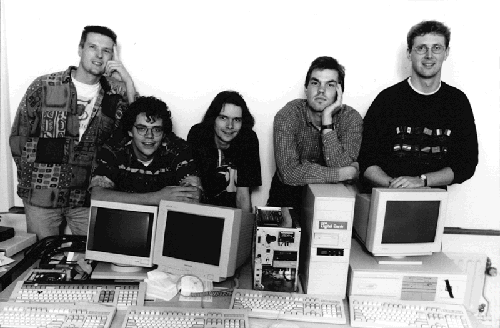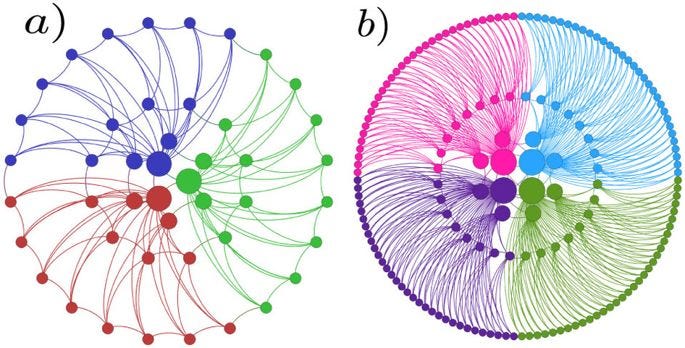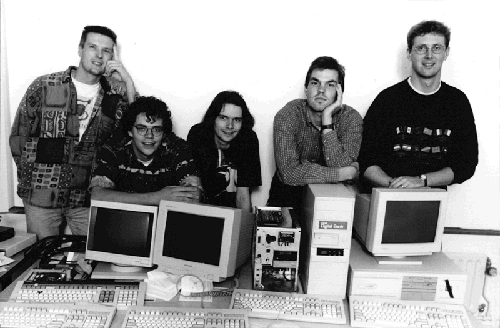One of the strangest things for me comes from the retrogression into things like proof of stake and the associated failed models of cryptocurrency. When I was working on Blacknet in 2005 and 2006, I stumbled upon what later became the solution to Bitcoin and the problems that I saw. DigiCash released eCash in the 1990s. It was a form of cryptocurrency that was more anonymous than Zcash or Monero, and it is nowhere to be found anymore. In part, the failure stems from an attack against the founding organisation, but it should also be noted that eCash continued even after the bankruptcy of David Chaum’s company. Creating a distributed group is not the solution people believe it to be. The problem is that they are not looking at the correct answer.

Many individuals acting in a distributed group on the same software program that is not a protocol that is fixed and immutable are in fact what everyone loves to call centralised. If we for instance take Zcash or Monero, or even Ethereum, every one of them comes back to a simple case of one organisation. Even where people love to say, “but we are decentralised,” they end in a single instance of an organisation. They neglect to note that they are under law an unlimited partnership.
Unfortunately, I have lost track of how much or little people know, especially when looking across disciplines. I have studied law, economics, computer science, history, mathematics, and even theology and ethics, and my greatest failure in doing so has been losing track of the understanding of the average person.
I did a master’s degree in statistics, in part to learn what I know now and also to understand propagation methodologies. It was during my studies that I first read a paper called “Ultrafast Consensus in Small-World Networks” [1]. Following the discovery, I spent years going down the rabbit hole of Newman and Watts [3]. The node structure in Bitcoin is linked to the ledger. Blacknet was a dead end not because it didn’t work but because some of the earlier methodologies that are completely separate to Bitcoin now worked anonymously. An anonymous system will never be scaled to the world. At best, an anonymous system forms a methodology for black markets and illicit and illegal trade. I was never interested in creating a dark-web money.
Bitcoin needed to be private and yet easy to stop or control such that illegal and illicit activity could be stopped at scale. Bitcoin as such forms what some have called a mandala network. Miners, as they are now called, form the nodes. There is no such thing as such a node, as in the system, it doesn’t work the same way. If you read the Bitcoin white paper on page 3, section 5 details it incredibly well in my opinion. The first point I put in section 5 is that “new transactions are broadcast to all nodes.”

Nodes can come and go, and they can choose how they interact with the system, but a node is not a wallet. What they do is validate transactions in the order of time in which they have received them, and as the paper says, “Nodes express their acceptance of the block by working on creating the next block in the chain, using the hash of the accepted block as the previous hash.”
There is no such thing as a full node that does not mine blocks.
In 2008, I published a number of methodologies that have been used within certain circles of law enforcement to do a mapping of systems forensically [2]. The concept of running an anonymous cash system through blockchain is one that is simple to control. It was designed in such a way. You see, although users can pseudonymously send transactions through VPNs and TOR, nodes cannot operate anonymously. The system is designed such that nodes that are building the ledger need to interact in a manner that leaves a trail.
Any anonymous blockchain system requires validation systems. The scale in a small world. The alternative is easy to “sybil.” I will be explaining the process behind it later in the year. If Bitcoin was to be a mesh network, it would require at least 11 and up to 30 hops to act in a distributed manner. An attacker, a government, or another party needs at most 2 to 3 hops worth of control to subvert the network. The Raspberry-Pi mentality does not even see that they make it incredibly simple to subvert the network. In order to subvert a mesh network, hardware worth around US$2000 is required. Such a system can create unbounded forking leaving the network percolation to branch endlessly or simply create an unbounded number of double spends.
Bitcoin solves the issue in a simple way: nodes become commercial.

I was explicit and clear with the point. Users do not run their own Usenet servers, they don’t generally run their own SMTP servers, and the idea of money is not to have some wizard-hatted technocrat dictating how everyone needs to run the same system. The system works because it is competitive. It’s what distribution means. It is why it is decentralised.
Bitcoin, any blockchain, is merely decentralised through competition. A system such as Ethereum is one entity. It is a loose partnership that is constructed at best as a formal partnership and at worst as a common-law partnership with unlimited liability. The reality here is that saying you are a distributed group means nothing under the law. If three people start acting together to create and implement software, and they don’t have a corporation or some other limited liability structure around them, then they are still a single enterprise, a partnership, and the worst part of it is that an unlimited-liability partnership leaves all parties equally liable.
When I said, “The current system where every user is a network node is not the intended configuration for large scale,” I don’t know how much clearer I could actually have been. As it says in my earlier post, “The more burden it is to run a node, the fewer nodes there will be. Those few nodes will be big server farms.”
Here is the thing: There is no other way that it can work in a small-world network. There is no other way that it can work in the Bitcoin node structure. Bitcoin is merely secure if the network distance for the miners, that is the nodes, remains at a level of D<3 or, in other words, the hop count is always under three hops. To achieve such an end, a number of large competing organisations will be created. I was incredibly specific in my point, and yet people seem not to understand me, and you wonder why I get so frustrated.
A thought experiment
Let us say, for instance, that AnonCoin has been created. It is a more anonymous, private, and secure coin than either Monero or Zcash could ever hope to be.
Now, there are two aspects of the system that we can incorporate into our analysis and thought experiment.
-
- There needs to be some manner of on-boarding onto other systems, and such is an exchange.
- As a blockchain system, it requires nodes. Such nodes act in a distributed consensus.
The overlooked aspect of any blockchain is the requirement for nodes to reach consensus in a provable manner. The primary way of doing so is a proof-of-work system. Parties cannot cheat, and the investment they have made is reflected probabilistically through the results of a proof-of-work system.
Individuals (or organisations) running nodes can split into smaller fragmented units, but doing so comes at a cost. Remember, we have a small-world network, and the more exit and entry points a node is required to manage, the greater the cost. There can be benefits for nodes to have exit and entry points in geographically distributed positions. There is a cost in acting as a set of separate players. Through the small-world nature of Bitcoin, it incentivises any attempt to “sybil” the network. Bitcoin is not a proof of work on finding a block solution but rather finding the block solution and ensuring that all others in the node network have your block to work on before anyone else discovers a competing block.
Consequently, Bitcoin is not about finding a block first. It is about distributing a found block.
Now, in our hypothetical AnonCoin, the nodes are distributed, and it is a blockchain. For it to work, it must be a small-world network. Miners are economically incentivised to act within the rules as it is very simple for other miners to discard dissenting players or nodes.
Nodes could attempt to have many entry and exit points acting in what seems to be an independent manner. But due to the nature of the system, it only makes them a larger target by increasing their attack space. In a manner of and analogous to my paper analysing the territorial behaviour of botnets, nodes in the AnonCoin network form an economic balance. Too large, and the cost of maintaining the systems becomes prohibitive, too small, and the distribution function for a global system becomes easy to subvert. The particular equilibrium will depend on the system, the number of nodes, and the value being traded.
In a proof-of-work system, nodes may be able to come and go, but the requirements for power dictate that it ends in large data centers. More importantly, the network consolidation of a small-world network leads to a small number of competitive miners. To be viable, a scaled system cannot be readily moved. The bandwidth necessary to distribute transactions and blocks to all miners directly without going through multiple hops consolidates nodes into large facilities. There can be hundreds of such facilities globally, potentially thousands for a scaled cryptocurrency, but such are not home-user systems. In fact, there is no way to create a system that is secure and globally distributed and to scale it using a blockchain other than a small-world distribution. No matter how it is constructed, a blockchain-based system collapses into a small-world network.
Recognising the small-world distribution is important. Every resilient system needs to be non-brittle. If AnonCoin seeks to be a system that acts outside the law, it is by nature brittle. Bitcoin was designed to ensure privacy and utterly destroy anonymity. It is an important distinction. Anonymity is the realm of cowards and those without courage. It is utterly different to privacy. Private transactions involve individuals, and leave traceable records. People can engage in private communications, and yet have no other party know who they are; different to anonymous transactions, each party in a private communication can trace the other one.
The first attack on AnonCoin is the exchange attack. In the US, bearer instruments have been made illegal. In time, the regulators will understand that systems such as AnonCoin and even by extension Zcash and Monero are bearer instruments. I am presenting in Oxford next month on the relationship between electronic transactions using blockchain and the fact that such are able to be taken as transactions in writing under English law.
Simply saying that our anonymous coin is illegal makes the exchange of such a coin illegal. Right now, the majority of exchanges are acting outside the law as illicit and illegal bucket shops touting the fact that they are (falsely) misleadingly able to trade without a license. The reality is very simple: Blockchain is a clearinghouse system. It does nothing to protect exchanges or to alter the law of transactional exchange, nor does it mitigate or remove the requirements to hold a license.
In time, it will be explicit and well understood, and such an exchange seeking to operate will be shut down or need to operate as a dark market allowing for the simple seizure of all asset.
The second part here is the requirement for nodes. There is no working system that will scale with billions of nodes. If the USA decided to ban and criminalise AnonCoin (as it arguably already is a bearer instrument), it effectively ends all use of AnonCoin within the USA . That simple.
When I designed Bitcoin, I was extremely careful in the node design. At scale, a blockchain is an immutable evidence store that acts in layers. Users are able to transact as if it was materialised cash and not a dematerialised electronic transfer. On an interesting side note, a lot of the economic design came from the study into alternative financial systems including Islamic jurisprudence, which I learned during my comparative international-law studies. Bitcoin is in fact (صكوك) ṣukūk in nature, and operates as a depreciating system within the constraints of one of the largest banking formats globally, one that allows smart contracts such as ones that comply with Murabaha, Ijara, Istisna, Musharaka, Istithmar, etc., while simultaneously allowing typical methods of Western finance.
The side note apart, it is a manner allowing an honest banking system that can track and trace all transfers leaving records and stopping crime.
Going back to our node situation, we have the scenario when nodes must invest. As with the research I conducted into distributed botnet controllers [4], Bitcoin-based systems form a distributed peer architecture that allows peer-to-peer cash between users which is settled on-chain. It’s what the nodes do. The nodes are the clearinghouse and settlement system. Such is the primary third party that is replaced. Bitcoin allows even banks to remove settlement functions and to distribute tokenised electronic cash in a manner that doesn’t require something such as the BIS or Bank for International Settlements.

Everybody is not a bank in Bitcoin. Banks offer services such as loans and the investigation into capital, and how it will be allocated in a manner that exceeds the nature of any automated system currently in existence. With Bitcoin, people have a method of securely storing cash. They can of course also tokenise many other goods and services allowing for more instantaneous, open, and secure trades to occur. It is a system where people cannot lose invoices and where negotiations can be stored permanently.
The authorities can easily determine the requirement for online service providers (OSPs) to handle the filtering of access in the reporting of such access to banned services. In 2008, I studied law at the University of Northumbria, Newcastle. I completed an LLM in international commercial law, and specialised in Internet intermediary liability. It was part of the key to Bitcoin. I needed to create a node system that allowed control yet freedom. What people fail to understand is that Bitcoin is about balance and neutrality. A set protocol is one that allows OSPs to compete fairly in all of the major jurisdictions globally. I have not considered North Korea. If you take the time to read the document that was my dissertation [5], you will note that I came to the conclusion that the simplest path was to restrict the end-state OSPs and hence the local jurisdictional node. In such a manner, individual governments can choose what they do and do not allow. Everything can be stored online, but not everyone can access it.
In the case of nodes, access is easily restricted, and ISPs can be required to filter certain types of access.
Personally, I do not like the idea of censoring open communication, but I do not believe in anonymous communications. It may, of course, seem ironic.
If made illegal (as I argue that AnonCoin already is within the USA), than an associated node is by nature illegal. It no longer matters how much is being transferred or even if the node operator is poor or rich; the simple fact of the matter is that it becomes a criminal act. Some of the methodologies I developed when working on tracing peer-to-peer networks can be used here. Nodes can’t hide in Bitcoin, and likewise, any blockchain with a proof-of-stake or any other thing that AnonCoin could possibly contemplate remains the same if it is developed using blockchain technology.
Now, such is the incredibly important part of any blockchain technology: nodes cannot hide. Bitcoin requires that the commercial nodes, the miners, the systems that run the network, and not the users, are available. They can come and go, but at the end of the day, they need to connect to and become part of the network. For the same reason, they can be detected and easily mapped. The one real problem that cannot be solved in all of it is that Bitcoin requires a stationary end node. If the requirement changes, the economic ability to earn diminishes. More importantly, nodes distribute to known addresses. They form mappings in the creation of an ultra-small-world map. It leads to a system that has the centre of the mandala network acting to ensure ultra fast consensus.
It is not the 10-minute settlement time but rather at scale milliseconds which secure transactions.
A node cannot operate as a commercial miner through TOR. If it uses a VPN service, it can be traced. The users connecting to the network, the individuals sending payments to merchants, they can maintain a level of anonymity and privacy conducive to the level of exchange that is being conducted. Even if they don’t divulge their identity, they can retain an invoice in an immutable form that cannot be exploited by criminal activity. Such is the real promise of Bitcoin. It is the balance between privacy and the need for safety and security whilst giving up neither. It is putting a cost on the tragedy of the commons and ensuring that privacy is valued.
The myth of AnonCoin is that it can operate anonymously. That nodes can operate at scale without being tracked or recorded or blocked. It is not the case. The only manner in which blockchain, the reality being bitcoin, but for the purposes here I will say any blockchain, can operate is within the existing legal framework. As soon as it divulges and acts without and outside such a framework, it is simple to block. And once the block occurs, the value diminishes.
No system based on proof of work can scale without value and nodes that can act validly within the network structure and within the law. There are other issues with proof of stake, and it can be used in the creation of a criminal system, but I will detail other flaws in time.
At its heart, this is what it’s about. I really don’t care if you commit a crime or not, if you buy and sell drugs or not, but what I do care about is that you have just left an evidence trail. If you do not like the law, lobby the parliament, become an MP or, if you’re in the USA, a congressman or whatever else, and seek to change it. I have zero tolerance for people who think that rebellion is an option in a working society, or rebelling for the sake of rebelling. In some societies, rebellion is an option. Bitcoin does not discriminate between government and citizen; it places the same transparency measures on both, and seeks to keep both honest.
Bitcoin scales perfectly well. The problem that those in Core and associated systems see is not with scaling but rather in the creation of a system that forgets. The entire path taken by the BTC Core development team in subverting what was Bitcoin into an air-dropped alternative system has been focused on creating something designed to allow drug markets. Simply put, there has been no other mainstream focus at any point since the collapse of Silk Road. Bitcoin is the truth machine.
It is what some people hate and seek to subvert.
They want something without records. Privacy is not enough. Privacy works when people are honest. What they seek is a system leaving records to be lost and one that allows criminals to breach the law with impunity. They want a system that allows terrorist funding, paedophilia, and everything else under the rocks that never see the sun. Bitcoin does not allow such things in any form.
Proof of stake
I’m sorry to inform you that proof of stake was actually one of the first things I investigated. It is a retrogression. Proof of work is far more advanced. I first looked at the idea of staking owners at around 2001/2, and spent a lot of wasted time investigating a dead end. Proof of stake is not stable. We have a proof-of-stake-based system in the US Fed right now. It’s not a stable form of money. Some will argue that the commodity theory of money has been discredited, but I will argue that even state-based fiat money forms a commodity function. It’s one that is driven through fear, yet it remains a commodity. It has a dual function as both an informational commodity and a taxation-based one. With a requirement to pay tax, it is an exchange good against such a rate. I’ll expand on it later in another post, leaving it to say that even fiat money forms commodity-based money.
I have posted before on proof of stake. I will dictate the mathematics behind the system and why it must fail later in the year. It will be in a peer-reviewed journal. I am not interested in helping you make fewer mistakes earlier, and I’m very happy for people to continue down such a road for now. I never said I was nice.
The simple end is that we don’t end up with an honest distributed system using any proof-of-stake model. More importantly, the consensus structure of the network does not evolve. In any model, proof of stake fails to form a consensus based on a small-world network, and the result of it is that it becomes simple to attack. I don’t expect you to take my word for it, but you have to wait till I publish; and very very simply put, I have no interest in saving the people going down such a trail.
For now…
Over the year, I plan to detail everything about Bitcoin. Little by little in my own time frame. Is not really my problem if you don’t like it, but such is how life works. If anyone should not like the court system, it would likely be me. Yet I understand it is the best we have. Following the Wolfe reforms, the legal system in the UK has improved quite a lot, but the fact is that it is still expensive and not open to the majority of people. The implementation of court-based signatures and electronic arbitration increases the democratisation of justice. It is something that is important to me. Justice is not about crime. It is ensuring that society works and is free.
References:
[1] Ultrafast Consensus in Small-World Networks (2005) http://authors.library.caltech.edu/5147/1/OLFacc05.pdf
[2] Wright, C. (2008) “Advanced Methods to Remotely Determine Application Versions” NS2008 LV, USA.
[3] Newman, M. E. J. & Watts, D. J. Scaling and percolation in the small-world network model., Phys. Rev. E 60, 7332 (1999).
[4] Territorial behavior and the economics of Botnets (2012) http://ro.ecu.edu.au/cgi/viewcontent.cgi?referer=http://www.reddit.com/r/btc/comments/7f9hjn/i_just_met_dr_craig_wright_in_malta/&httpredir=1&article=1148&context=ism
[5] Wright, Craig S. The Impact of Internet Intermediary Liability (April 17, 2008). Available at SSRN: http://ssrn.com/abstract=2953929 or http://dx.doi.org/10.2139/ssrn.2953929

